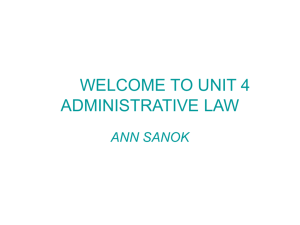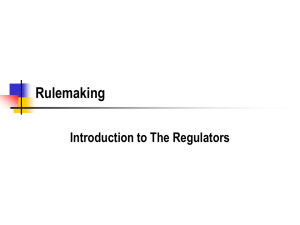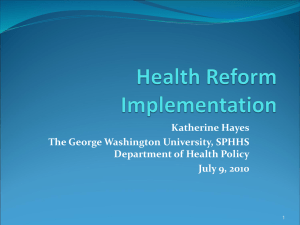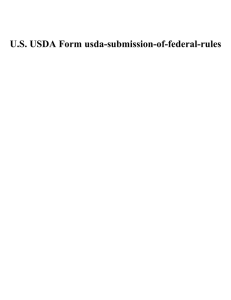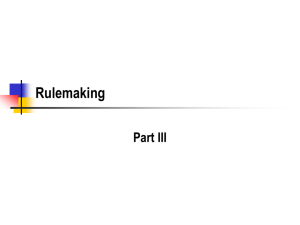Rulemaking Part II
advertisement
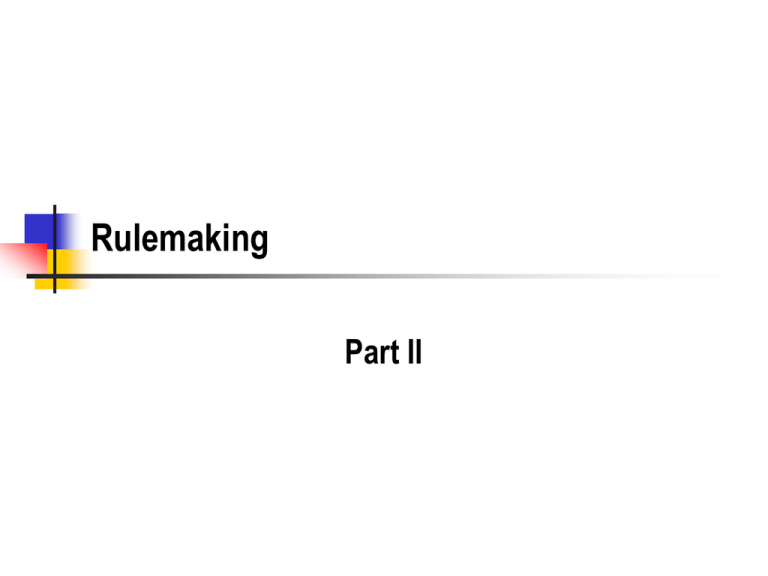
Rulemaking Part II Procedural Rules Procedural rules are exempt from notice and comment The form of an application for benefits is procedural The facts that the claimant has to establish to get the benefits are substantive A procedural rule can become substantive if the change in procedure has a substantial impact on the regulated parties. Procedural change for submitting bills by home health providers imposed a huge logistic and financial cost. 2 OSHA Guidance for Targeting and Carrying out Inspections Being inspected does have a substantial impact on the employer Does this guidance document require notice and comment? Does it change the legal rights of the employers? 3 What is Formal Rulemaking? A rulemaking conducted as a trial type hearing The agency support for the rule must be presented at the hearing Interested parties may present and cross-examine evidence History - grew out of rate making Rate making affects a small number of parties The courts thought they should get due process 4 Why avoid formal rulemaking? The peanut hearings (FDA must do formal rulemaking in some situations) Should peanut butter have 87 or 90% peanuts? 10 years and 7,736 pages of transcript What was the concern in Shell Oil v. FPC? Formal rulemaking was impossibly time consuming to use for regulating something changeable such as natural gas rates. Why does just getting the right to be heard at a formal hearing benefit parties that oppose a rule? 5 When is Formal Rulemaking Required? Disfavored by the modern courts Must have magic statutory language or be required by the agency's on rules Only when rules are required by statute to be "made on the record after opportunity for an agency hearing" Lawyering tip When would you want to argue that formal rulemaking is required? What do you have to do to support you request? 6 The Procedures of Notice-and-Comment Rulemaking Putting the Notice in Notice and Comment 553(b) . . . The notice shall include — (1) a statement of the time, place, and nature of public rulemaking proceedings; (2) reference to the legal authority under which the rule is proposed; and (3) either the terms or substance of the proposed rule or a description of the subjects and issues involved. . . . 8 Notice of the Proposed Rule: Chocolate Manufacturers Ass’n v. Block What did Congress tell the agency to do that resulted in these regs? WIC What did the proposed rule address? Cereal What about fruit juice? How was the final rule different from the proposed rule? 9 The Notice Problem What was the CMA's claim? What was the agency defense? Does the rule have to be the same? Why have notice and comment then? What is the logical outgrowth test? How would you use it in this case? What did the court order in this case? What will the CMA do? 10 Limits on Logical Outgrowth - Arizona Public Service Co. v. E.P.A. What did the EPA propose that Indian Tribes be allowed to do that states were doing? State plans are subject to judicial review - Why did the tribes object to this in comments? How was the rule changed? What was the claim by plaintiffs? How did the court analyze the problem? Why shouldn't have been a surprise? 11 What about Technical Information Underlying the Rule? (not in book) Portland Cement v. Ruckelshaus, 486 F2d 375 (1973) The agency must disclose the factual basis for the proposed rule, if it relied on scientific studies or other collections of information Connecticut Light and Power v. NRC, 673 F2d 525 (1982)? The agency cannot hide technical information. Why is this a big deal in environmental regs? What are the potential downsides of this policy? 12 Shelby Amendments to the Freedom of Information Act (not in book) As we will learn later, the FOIA traditionally applied only to information in possession of government agencies Senator Shelby, at the urging of several business lobbies, successfully extended FOIA to information produced by federally funded research and in the hands of universities Why would business lobbies want access to this information, esp. in environmental rulemakings? Why might such access be a problem for professors? 13 Additions to the Published Record (not in book) Rybachek v EPA EPA added 6000 pages of supporting info when responding to comments Court said the agency may supplement the rulemaking record in response to comments asking for explanation Idaho Farm Agency added a report to the record, then relied on it in the final rule. The agency may not add new material and then rely on it without given an opportunity to comment on it. 14 Negotiated Rulemaking What is this? Why is often used in environmental rulemaking? What are the advantages? What are the public participation issues? 15 Ex Parte Communications Rulemaking How does the notice provision in rulemaking change the issues in ex parte communications? How does the notice requirement eliminate the ex parte communications issues for communications before the promulgation of the rule? When are ex parte communications an issue? How can you cure this? 17 Bias and Prejudice Remember the cases on bias of decisionmakers in adjudications? Should these also apply to rulemaking? How does notice and comment change the situation? 18 Association of National Advertisers , Inc. v. FTC FTC is adopting rules on TV advertising directed at children Chairman has written and spoken at length on the evils of TV ads aimed at children Plaintiffs seek to disqualify him because of bias Court held that plaintiffs must show clear and convincing evidence that he has an unalterably closed mind on matters critical to the rulemaking No rulemaking has ever been overturned on the basis that a decisionmaker was unlawfully prejudiced. 19 DC Federation of Civic Associations v. Volpe, 459 F.2d 1231 (D.C. Cir. 1971) The Volpe test for whether a rulemaking may be overturned solely on evidence of Congressional pressure 1) was there specific pressure on the agency to consider improper factors? 2) did the agency in fact change its mind because of these considerations? How can the agency defend itself from a Volpe attack? What did the Court Rule when it applied Volpe to this Case? Why is it proper for congressmen to comment on proposed rules? 20 Sierra Club v. Costle, 657 F.2d 298 (D.C. Cir. 1981) Rule making on coal fired power plants Why is this controversial then and more so now? Sierra Club claimed that the president influenced the agency Is that wrong? What is the cure? Senator Bird also weighed in What do plaintiffs need to show to establish undue influence? Why is an outcome test, combined with the record, a good solution? 21 What is the president's role in rulemaking? Controls and supervises executive branch decisionmaking How is the role different in adjudications? When should the president's contacts be documented? When the statute requires that they be docketed If the rule is based on factual information that comes from such a meeting. 22 Should State Rules Differ from Federal Rules on Notice and Comment? Limited staff Greater reliance on the expertise of board members, rather than staff Board may hear lots of testimony and review a lot of info - they cannot afford the time and effort to put together volumes of supporting info for regs Should state agencies have a reduced publication requirement? Should they be able to publish rules without explanation and only have to explain if asked? 23 Congressional Mandates (Hybrid Rulemaking) at the FTC issue an advance notice of proposed rulemaking, which describes the area of inquiry under consideration and invites comments from interested parties; send the advance notice and, 30 days before its publication, the notice of proposed rulemaking to certain House and Senate committees; hold a hearing presided over by a hearing officer at which persons may make oral presentations and in certain circumstances to conduct cross-examination of persons; include a statement of basis and purpose to address certain specified concerns; and conduct a regulatory analysis of both the proposed and final rules that describes the proposal and alternatives that would achieve the same goal and analyzes the costs and benefits of the 24 proposal and the alternatives.
![Minnesota Department of [Name] MEMORANDUM](http://s2.studylib.net/store/data/015049440_1-475d22d0ab7bd661c71329dec0ae8429-300x300.png)
